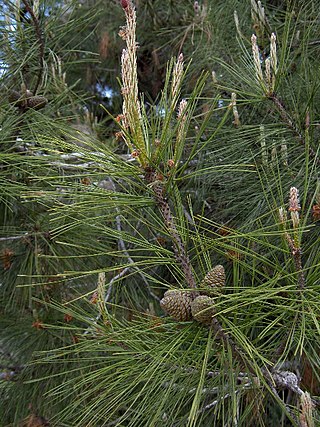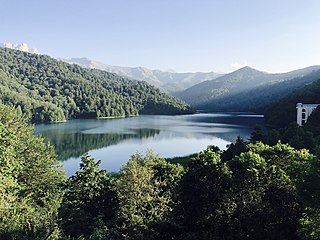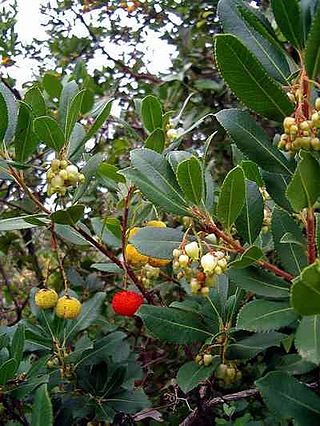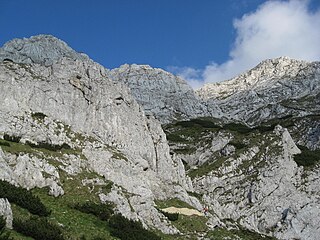
Temperate rainforests are rainforests with coniferous or broadleaf forests that occur in the temperate zone and receive heavy rain.

Pinus brutia, commonly known as the Turkish pine and Calabrian pine, is a species of pine native to the eastern Mediterranean region. The bulk of its range is in Turkey, but certain varieties are naturalized as far east as Afghanistan. It is also known as East Mediterranean pine, Afghan pine, and Brutia pine. The name "Calabrian pine" comes from an introduced grove in the Calabria region of southern Italy; historically this region was called Bruttium, which is likely where the specific epithet "brutia" comes from. Pinus brutia bears many similarities with other, closely related species such as Pinus halepensis and Pinus canariensis. Turkish pine forms a species complex with the former.
National parks of Azerbaijan are run by the Ministry of Ecology and Natural Resources in the Republic of Azerbaijan. The first national park established was Zangezur National Park in 2003. Since then, a further 9 national parks have been established; the most recent being the Gizilaghaj National Park in 2018.

Hirkan National Park is a national park in Azerbaijan, in the Talysh region. It was established in an area in Lankaran Rayon and Astara Rayon administrative districts on February 9, 2004 on the basis of the former "Hirkan State Reserve" which it superseded, on a surface area of 29,760 hectares (297.6 km2). It was enlarged by presidential decree on April 23, 2008 from 29,760 hectares (297.6 km2) to 40,358 hectares (403.58 km2).
Absheron National Park is a national park of Azerbaijan in the Caspian Hyrcanian mixed forests' ecoregion. It was established on 8 February 2005, on an area of 783 hectares (7.83 km2) in the administrative territory of the District of Azizbeyov in the City of Baku, on the base of Absheron State Nature Preserve. The park is the mostly visited by from foreign visitors.

Göygöl National Park — is a national park of Azerbaijan. It was established in an area in Goygol Rayon administrative district on April 1, 2008, on the basis of the former "Goy Gol State Reserve" that was established in 1925 and which it superseded, on a surface area of 12,755 hectares (127.55 km2). It was enlarged from 6,739 hectares (67.39 km2) of the former state reserve to its current surface area as a national park. The park is the most visited in the country.

Zagatala State Nature Reserve – is a reserve in the Zagatala and Balakan districts of Azerbaijan. It was established in 1929 in the middle part of the southern foothills of the Greater Caucasus Mountains in the territory of Zagatala and Balakan districts on an area of 25200 hectares. It is located on the eastern slope of the Greater Caucasus Range in Azerbaijan. Zagatala Reserve was established in 1930-0 as a separate reserve together with the Balakan Reserve. The height of the reserve varies from 650 to 3646 m above sea level. The flora of the base of the reserve consists of mountain forests and mountain meadows. More than a thousand species of modern flora are observed here. [2] The territory of the reserve has changed many times and now stands at 28,844 hectares. There are more than 900 plant species in the reserve, which is 1/6 of the flora of Azerbaijan. More than 60% of the reserve area consists of broadleaf forests. The main purpose of the reserve is to protect the natural complexes of rare plants on the southern slopes of the Greater Caucasus Mountains.
Gara-Gel State Reserve or Qaragol State Reserve was established on the area of 240 hectares in 1987 for protection and preservation of rare ecological system of the lake of glacial origin and natural complexes surrounding the water basin. The lake feeds mainly from rains and spring water. Lake Ishigli-Gara-Gel is situated at a height of 2, 658 m above sea level in the southern part of the Karabakh volcanic plateau near the foothills of several mountains with a height of 3, 200-3, 500 m. the lake is a relict water reservoir, which was formed in the crater of an extinct volcano. The length of the lake is 1,950 m, its maximum width is 1, 250 m, length of its coastline is 5, 500 m, maximum depth – 7.8 m, volume of water – 10 million m3, area of the lake 13 km2. Water flow is mainly due to melted snow and rainwater, partially spring water. In terms of botany and geography the Karabakh Plateau is situated between the Caucasian and Armenian-Iran provinces, which determines the specifics of the local flora. The flora of the reserve includes 102 species and subspecies of vascular plants from 68 general and 27 families. The lack of flora is explained by the fact that the reserve covers only the lake, and many rare and endemic species grow beyond the reserve area, but close to its borders. The vegetation of the coastal area of the lake is represented mainly by meadows with the dominance of Trifolium and Tragacantha and Astragalus. The swamp flora and vegetation are limited because of the height of the area. There are only two species of plants in the lake: Polygonum amphibium and Ranunclus. In 1967, a type of Sevan trout, included in the Red Book, was introduced into the lake. The reserve is an inter-republic reserve. The reserve is under occupation. Adjacent to the borders of the reserve there are areas with rare and endangered species of plants such as Euphrasia, Potentilla and others.

The wildlife of Azerbaijan consists of its flora and fauna and their natural habitats.

The Hyrcanian forests are a zone of lush lowland and montane forests covering about 55,000 square kilometres (21,000 sq mi) near the shores of the Caspian Sea in Iran and Azerbaijan. The forest is named after the ancient region of Hyrcania. The World Wide Fund for Nature refers to the ecoregion as the Caspian Hyrcanian mixed forests. Since 5 July 2019, the Hyrcanian Forests have been designated a UNESCO World Heritage Site. In September 2023, the heritage site expanded to incorporate portions of the forest located in Azerbaijan.

The flora of Italy is all the plant life present in the territory of the Italian Republic. The flora of Italy was traditionally estimated to comprise about 5,500 vascular plant species. However, as of 2019, 7,672 species are recorded in the second edition of the flora of Italy and in its digital archives Digital flora of Italy. In particular, 7,031 are autochthonous and 641 are non native species widely naturalized since more than three decades. Additionally, further 468 exotic species have been recorded as adventitious or naturalized in more recent times.

Dilijan National Park is one of the four national parks of Armenia. Occupying an area of 240 km², it is located in the north-eastern Tavush Province of Armenia. It is known for its forest landscapes, rich biodiversity, medicinal mineral water springs, natural and cultural monuments, and extensive network of hiking trails.

The Apennine deciduous montane forests are a temperate broadleaf and mixed forests ecoregion in the Apennine Mountains of Italy. The development of these forests is ensured by the high rainfall in the Apennines, combined with a temperate-cool climate. Because of climate change, the presence of silver fir, although still widespread, has been dramatically reduced in favour of beech.

Khosrov Forest State Reserve, is a nature reserve in Ararat Province of Armenia. The reserve is one of the oldest protected areas in the world having a history of about 1,700 years. It was founded in the 4th century (334–338) by the order of king Khosrov Kotak, who gave it his name. It was founded to improve the natural climatic conditions of adjacent territories of Artashat – the capital city of Armenia of the given period and the newly established city of Dvin to ensure conservation and enrichment of flora and fauna; serve as a ground for royal hunting, military exercises and entertainment.

The wildlife of Chechnya includes a range of flora, fauna, and funga as reflected by its varying topographic and climatic conditions, with the Greater Caucasus to the south, the foreland zone the Terek and Sunza river valleys in the west and east, and the rolling plains of Nogai steppe in the north. Lake Kezenoyam in Chechnya is near the border with Dagestan and can sustain plankton growth. Salmo ezenami, a rare species of trout now critically endangered due to introduction of the invasive species European chub, is native only to this lake and is therefore endemic to Lake Kezenoyam.

Lagodekhi Protected Areas, also known as Lagodekhi National Park, is a pair of protected areas in the Kakheti district of Georgia: Lagodekhi Strict Nature Reserve and Lagodekhi Managed Nature Reserve. The combined area of the two is 24,451 hectares (94.41 sq mi). The reserves are located in north-eastern Georgia on the southern slopes of the Caucasus and border Azerbaijan and Dagestan. Lagodekhi preserves a variety of rare local flora and fauna and was originally protected in 1912, under the Russian Empire, becoming the first such nature preserve on the territory of present-day Georgia. Their ecoregion is that of the Caucasus mixed forests.

The total forest area of Azerbaijan is 1,021,880 ha or 11.8% of the country's area. The forest biomes consist of temperate deciduous forests, temperate broadleaf and mixed forests, temperate coniferous forests and riparian forests. Specialists estimate that in the 8th-9th centuries the forest cover was around 30-35%, most of it situated in mountainous areas.

The Espinal (NT0801) is an ecoregion of dry, thorny forest, savanna and steppe in Argentina. It has been extensively modified by large scale cattle ranching, but remnants of the original flora remain. It is threatened by the advance of the irrigation-based agricultural frontier.

Chachuna Managed Reserve is a protected area in the Dedoplistskaro Municipality in Kakheti region of Georgia in the south-eastern part of the country near the border with Azerbaijan in floodplains of Iori River. Chachuna Managed Reserve was established in order to protect forests on the banks of the Iori river and Dalis-Mta reservoir and it characteristic arid and semi-arid types of flora and fauna. On the reserve territory there are several bird hides for birdwatching. Chachuni Managed Reserve was established in 1996 mostly on the territory of former Chachuni State Forestry which was in existence since 1965. The Administration of Chachuna Managed Reserve is located in Dedoplistskaro in shared facility with Vashlovani Protected Areas Administration.

Piatra Craiului National Park is a protected area of national interest in Romania corresponding to IUCN category II, located on the territories of Argeș and Brașov counties. Located on the Piatra Craiului Massif, it is largely karstic.




















